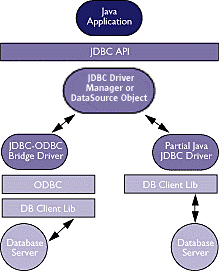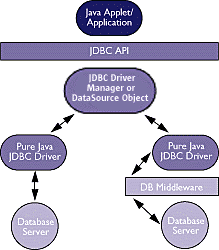JDBC Tutorials - Herong's Tutorial Examples - v3.14, by Herong Yang
JDBC Driver Types
This section provides some quick information about different types of JDBC drivers.
JDBC drivers can be implemented in 4 ways. So JDBC drivers are divided into 4 types:
JDBC Type 1: JDBC-ODBC Bridge plus ODBC Driver. See the left side of the first picture shown below. This combination provides JDBC access via ODBC drivers. ODBC binary code, and in many cases, database client code, must be loaded on each client machine that uses a JDBC-ODBC Bridge. Sun provides a JDBC-ODBC Bridge driver, which is appropriate for experimental use and for situations in which no other driver is available.
JDBC Type 2: A native API partly Java technology-enabled driver. See the right side of the first picture shown below. This type of driver converts JDBC calls into calls on the client API for Oracle, Sybase, Informix, DB2, or other DBMS. Note that, like the bridge driver, this style of driver requires that some binary code be loaded on each client machine.
Below is an integration diagram of JDBC Type 1 and 2:

JDBC Type 3: Pure Java Driver for Database Middleware. See the right side of the second picture shown below. This style of driver translates JDBC calls into the middleware vendor's protocol, which is then translated to a DBMS protocol by a middleware server. The middleware provides connectivity to many different databases.
JDBC Type 4: Direct-to-Database Pure Java Driver. See the left side of the second picture shown below. This style of driver converts JDBC calls into the network protocol used directly by DBMSs, allowing a direct call from the client machine to the DBMS server and providing a practical solution for intranet access. For example, Microsoft JDBC Driver 1.0 is a Type 4 JDBC driver.
Below is an integration diagram of JDBC Type 3 and 4:

Table of Contents
►JDBC (Java Database Connectivity) Introduction
Establishing Connections from JDBC to Databases
DriverManager - Loading JDBC Driver
DriverManager - Connection URL
Installing and Running Derby (Java DB)
Derby (Java DB) JDBC DataSource Objects
Derby (Java DB) - DML Statements
Derby (Java DB) - ResultSet Objects of Queries
Derby (Java DB) - PreparedStatement
Summary of JDBC Drivers and Database Servers